How Can Human Systems in Response in Physical Environment Conditions
Study Session i Human Interactions with the Environment
Introduction
This Module is well-nigh the context and background to h2o, sanitation and hygiene (Wash) in Federal democratic republic of ethiopia. The Wash sector is concerned with provision of safe water, the separation and management of wastes, and promotion of hygienic practices to improve people'southward health and well-being. To understand the context of the WASH sector you need to understand the nature of the interactions between usa as human beings and our environment.
Humans demand to interact with the environment to obtain our food, water, fuel, medicines, building materials and many other things. Advances in science and technology accept helped united states to exploit the environment for our benefit, only we have besides introduced pollution and caused ecology damage. The bear upon of ecology issues on humans is meaning, affecting all human activities, including health and socio-economic evolution. In this study session you will learn about the relationships between humans and the surround, and the ways in which we utilize environmental resources. This written report session introduces you to many of the topics that are further developed later in the Module.
Learning Outcomes for Study Session i
When you accept studied this session, yous should be able to:
1.i Define and utilise correctly all of the central words printed in assuming. (SAQs 1.i and ane.3)
i.2 Depict the relationships betwixt man activities and the environment and explicate the importance of creating a ameliorate surroundings. (SAQ 1.two)
ane.3 Describe the ways in which humans use natural resources and give examples of problems acquired by over-exploitation. (SAQ 1.3)
1.iv Give examples of positive and negative ways in which technology affects the environment. (SAQ 1.4)
one.one Relationships between man action and the environment
Our environment ways our concrete surroundings and the characteristics of the place in which nosotros live. Information technology also refers to the wider natural world of land, sea and temper. Humans have been interacting with their environment since people commencement walked the World. For example, humans take been cut downwardly forests to clear state to grow crops for centuries and by doing so we accept altered the environment. Conversely, the environment affects united states in many different ways equally well. A simple example is the style we modify our dress in response to cold or hot atmospheric condition. In this section we will introduce some of the means in which humans influence their environment and how the environment influences the states, both positively and negatively.
A adept climate, attainable make clean water, fertile soil, etc. are aspects of the physical environment that enable people to live and thrive. Yet, harsh environments, such as a very hot climate, limited water and infertile country, make it more hard for people to survive. We are as well affected past major environmental events such equally earthquakes, floods and drought that impairment homes, property and agriculture. These can atomic number 82 to the displacement of people and can cause injury, loss of life and destruction of livelihoods. They can also damage water sources and pipelines, causing h2o contamination and spreading waterborne diseases. In Report Session x you will learn more virtually the effects of floods and droughts.
Our relationship with the environment changed with industrialisation, which began in the 18th century in the Great britain, soon followed by elsewhere in Europe and North America, and then spreading across the world. Prior to industrialisation, the impacts of human being activity were not very pregnant because the technologies used were non capable of modifying the environment on a large scale. People at that time lived in agricultural societies using hand tools and elementary technologies with limited ecology impact (Effigy 1.1). Industrialisation has immune for a greater exploitation of resources. For example, we now use powerful chainsaws to cut down trees and industrially produced chemical fertilisers and pesticides for ingather production. These changes accept chop-chop increased the human bear upon on the environment.
The links between deed and the environment are complex and varied, but can exist grouped into two main types of activeness:
- use of natural resources such equally land, food, water, soils, minerals, plants and animals
- production of wastes from a range of activities including agriculture, industry and mining, too as wastes from our ain bodies.
These are described in the following sections.
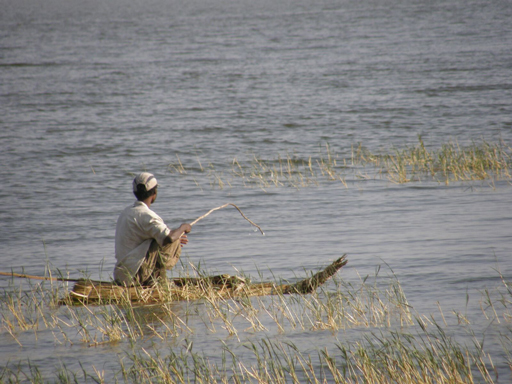
Figure 1.1 Fishing on Lake Awassa using simple technologies.
1.two Use of natural resources
Nosotros use many different types of natural resource in our daily lives. We depend on food and water for survival and we need free energy for many unlike purposes, from domestic cooking through to major industrial processes. Our dress, transport, buildings, tools and all other items we use require many different resources for their product. Let's take a simple case. Remember most the resources that have been used to produce a notebook of the type you may exist using correct now as you report this Module. Manufacturing the paper needed raw materials of wood and water also equally energy for the production procedure. The copse that supplied the woods required soil, water and land to grow on. At that place may be ink or metal staples or other components in your notebook that were made from other types of resources. Our need for resources is vast and it is growing every bit the population increases and consumption per person increases with socio-economic progress. Depletion of natural resources by extraction and exploitation is peculiarly of business organization for non-renewable resources (come across Box ane.1).
Box 1.1 Renewable and not-renewable resources
The resources nosotros use can be classified as renewable or not-renewable. The basic divergence between the ii is the rate at which they are regenerated back into a usable form, relative to the rate at which they are used past humans. Not-renewable resource cannot exist replenished by natural means every bit quickly as the rate at which they are consumed. They include minerals and fossil fuels such as oil, coal and gas, which are formed over millions of years by natural processes from rust-covered plants and animals.
Renewable resources are constantly available or regenerated over curt timescales by natural processes. Some renewable resources, such every bit solar free energy, are not modified or used up by humans. Others, such as water, are altered when nosotros use them and can be over-exploited or damaged such that the resource is no longer available for use.
-
Can yous suggest another renewable resources that are replenished naturally but need to exist managed properly and not over-exploited?
-
You may take suggested examples such as woods, animals and plants. For example, trees are cutting downwardly to provide forest and they will regrow just they need time to regenerate.
Globally, both population and resources extraction increased by about fifty% in the 25 years from 1980 to 2005 (SERI et al., 2009). Over that fourth dimension, the world population increased from 4.44 billion in 1980 to half-dozen.49 billion. Figure i.2 shows how the extraction of natural resources increased between 1980 and 2005 from 40 billion tonnes to 58 billion tonnes. The graph shows the extraction of 4 types of natural resource: fossil fuels, biomass, metals and minerals. Biomass means biological material derived from living organisms such as crops, livestock, fish, wood, etc. Metals are used in the manufacture of a wide range of goods – from cars to computers. Minerals are used in industrial processes and in structure to build our houses and roads. Both metals and minerals are obtained from rocks that have been mined and are then candy in various ways to extract the valuable resource.
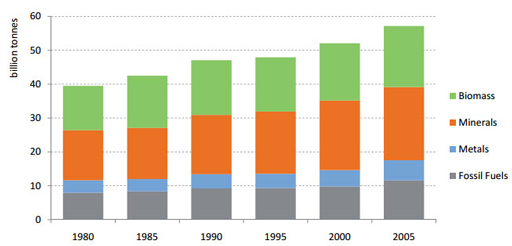
Figure one.2 Global extraction of natural resources, 1980 to 2005. (SERI et al., 2009)
-
Look at Figure 1.2. What is the design of natural resource extraction from 1980 to 2005 and what do you remember could exist the reason?
-
Natural resource extraction shows a steady increase from 1980 to 2005, with the greatest amount extracted in the near recent twelvemonth (2005). The most likely reason is the increase in the global population in this menses; more people need more resources. Information technology could too be the case that the amount used by individuals and by wider lodge is increasing due to changes in behaviour and levels of consumption.
Advances in technology have increased natural resources exploitation by enabling people to achieve new resources and to exploit more resources per capita (per person). For example, fishermen who use traditional technologies such as small boats are limited in the number of fish they can grab. Modern industrial fishing fleets use very large ships that cover huge areas of bounding main at greater depths to catch many more than fish. This can lead to overfishing, which means catching fish at a faster rate than they can reproduce.
-
Are fish a renewable or non-renewable resource?
-
Fish are a renewable resource. However, if fishing is not managed properly and more fish are taken from the water than can be replaced naturally, the fishery will fail.
Overfishing and other examples of over-exploitation of natural resources can result in damage to or the loss of unabridged ecosystems.An ecosystem includes all the living organisms (humans, plants, animals, micro-organisms) and their physical environment (soil, water, air, country) and the interactions between them. If 1 component of the system is removed, this can have knock-on effects on the other parts of the system.
1.2.1 Deforestation
I particular problem caused past over-exploitation of natural resources is deforestation, which occurs when woods areas are cleared and the copse are not replanted or allowed to regrow. In Ethiopia, clearing land for agriculture to meet the food needs of the growing population and the need for fuel and construction materials has resulted in a steady loss of forest expanse, which is still continuing as you tin can see from Figure one.three.
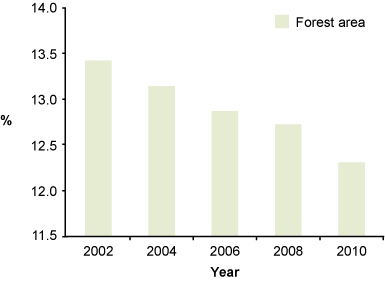
Figure ane.iii Proportion of land area in Ethiopia covered by forest (%) from 2002 to 2010. (MoFED, 2012a)
The loss of woods has several undesirable consequences. Forests are domicile to many different types of trees, also every bit other plants, and a wide range of animals from insects to birds and mammals. The conversion of forests to agriculture profoundly reduces biodiversity, which is a measure of the diversity of living organisms (all life forms). Biodiversity is important for humans considering we employ other living organisms to provide several essentials:
- Food: we employ plants and animals such as fish, goats, wheat, rice and maize every bit sources of nutrient.
- Medicines: many traditional medicines are made from plants and animals and new medicines are developed from them.
- Ecological services: living organisms, especially plants and micro-organisms, play an important function in processes that maintain our lives and surround such as providing oxygen, cleaning the air, purifying water, breaking down wastes and controlling erosion.
Deforestation is a significant contributory cause of soil erosion. Once the trees and undergrowth are removed, the underlying ground is exposed. Without the intercepting effect of the vegetation and the tree roots binding the soil together, the soil is more than likely to be washed abroad when it rains. Loss of forests likewise has a significant bear on on water supply. Tree roots attain deep into the soil and create spaces between the particles which increases soil permeability, allowing rainwater to soak in and replenish groundwater. (Permeability means the ease with which water moves through soil or rock.)
1.2.2 Energy resources
The use of renewable or not-renewable resource is a critical cistron when considering energy resources. Fossil fuels take been the primary free energy source for global industrialisation, but considering they are non-renewable, the quantity is ultimately express and their use is non sustainable over the long term. Furthermore, burning of fossil fuels is the main cause of climatic change. (Climate alter is discussed fully in later report sessions.) There are several renewable alternatives to fossil fuels. Wood used as a fuel is renewable in the sense that trees will regrow simply at that place are other disadvantages such every bit deforestation, equally you lot accept read. In Ethiopia, windfarms are harnessing wind ability to generate electricity (Figure 1.4) but the almost important source of renewable energy in Ethiopia is water. Ethiopia already has several hydropower stations and more are planned, including the Thousand Ethiopian Renaissance Dam, currently nether construction. Hydroelectric power is renewable because it makes use of the free energy of flowing h2o but does not utilise up the water in the process. Another renewable energy source is solar power, using photovoltaic cells that convert the dominicus'southward energy into electricity.
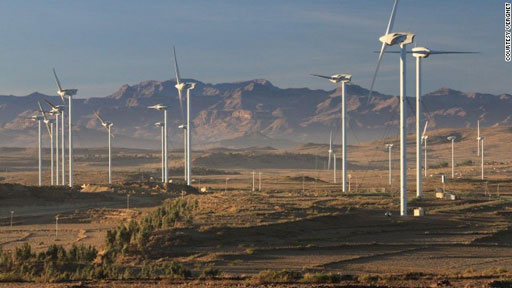
Figure one.4 Windfarm at Ashegoda, Tigray Region.
ane.2.three Water resource
Y'all may have noticed that the four categories of resources shown in Figure 1.two practise not include water, and yet this is 1 of our about vital resources and is obviously fundamental to the Launder sector. The directly use of water by people falls into three chief categories:
- domestic uses, including drinking, washing and cooking
- agricultural uses, principally irrigation
- industrial uses, in manufacturing processes and for energy generation.
The relative proportions of these three categories vary in different parts of the world, just globally the sector using the virtually water is agriculture (FAO, 2012) (Figure 1.five).
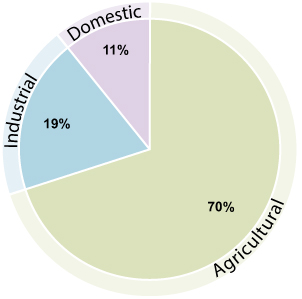
Figure 1.five Global h2o withdrawal past sector. (Adapted from FAO, 2012)
Likewise every bit direct use of water for human activities, water is also essential for the environment and to maintain biodiversity. Rivers, lakes and wetlands are important habitats for wildlife and need a minimum amount of water at all times. This becomes a problem when the demand for water for human being activities exceeds the supply.
Water is non an incessantly renewable resource. In many parts of the earth water demand is significantly higher up sustainable water supply. Sustainable water supply means at that place are adequate supplies, in both quality and quantity, to see the current and future needs of people and of the surround.
Many countries are already experiencing water stress or scarcity. These terms refer to the volume of water available relative to the apply and demand for it, which is linked to the population served. Figure ane.vi shows the availability of freshwater across the world. Countries which take less than 1700 thou3 of h2o per person per year for all purposes are divers every bit water stressed (United nations, 2014). Water deficient countries take been defined as those with less than m mthree of h2o per person per year. These precise figures should be used with caution, however, considering they do non recognise variations between countries and they hibernate the underlying causes of water scarcity.
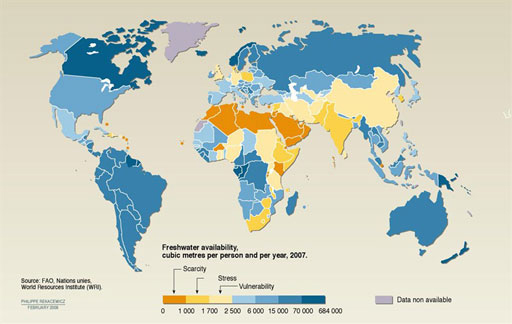
Figure 1.6 Global freshwater availability in cubic metres (miii) per person per year (2007). (Annotation that although calculated 'per person', these figures apply to all uses of water non just personal use.) (WWAP, 2012)
Increasing water need leads to unsustainable use of h2o resources. By the actions of the water cycle (which yous volition learn nigh in Study Session 4) water supply is replenished, but taking excessive amounts of water from rivers and groundwater for domestic, industrial and agricultural use decreases the amount of water available for current and hereafter generations. Globally, water withdrawals take tripled over the last 50 years due to population growth and to increased consumption per person. Many areas with plentiful supplies tin sustain this use, simply in some countries the futurity may bring water shortages unless demand is managed.
-
If the trend for increased consumption continues, what could be the outcome for Ethiopia?
-
As you tin can come across from Effigy 1.6, Ethiopia is already classed as existence under h2o stress. If consumption increases due to population growth and/or increased utilize per person, this could put Ethiopia into the water scarcity category.
In exercise, for Ethiopia, the trouble of h2o supply is not and so much about the volume of h2o that is available. The problem is the infrastructure and investment required in delivering acceptable quantities of prophylactic h2o to all the people wherever they alive. The availability of water and admission to a rubber supply varies considerably throughout the state and betwixt rural and urban populations.
Case Written report 1.1 illustrates the problems that can ascend from excessive h2o use.
Case Study i.ane Furnishings of water utilize on Lake Alemaya
Lake Alemaya in the Ethiopian Highlands has always provided local people with h2o for drinking and domestic utilize, for irrigating crops, watering livestock and fishing. In the mid-1980s it was around 8 1000 deep and covered 4.72 km2. However, by 2005 the amount of water in the lake had dropped dramatically (Figure i.vii) and the size of the lake had fallen (UNEP, n.d. 2).
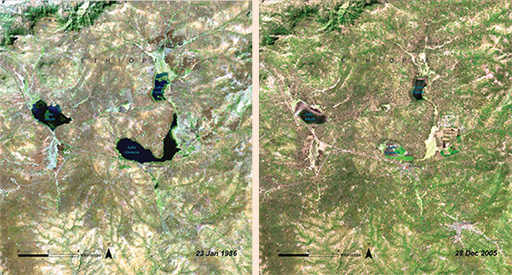
Effigy 1.7 Loss of h2o from Lake Alemaya, between 1986 and 2005. (UNEP, n.d. 2)
Information technology is believed that changes in water utilize by local people and changes in the local climate are responsible. The employ of domestic water and also water for irrigation (especially for growing khat) has increased significantly. Deforestation of the surrounding area, equally country is cleared for farming and to meet an increasing demand for wood, means that tree roots no longer hold the soil together and it is done off the hillsides into the lake. This causes information technology to silt up and reduces the capacity of the lake. Warming of the local climate may also have had an outcome, increasing the rate of evaporation from the lake. Recently, lack of water in the lake has interrupted water supply to Harar, a nearby town of over 100,000 people.
-
What are the possible causes of the loss of h2o from Lake Alemaya?
-
Increased use of h2o for domestic uses and for irrigation, deforestation leading to soil erosion and silt deposition in the lake, and perchance climate change.
1.iii Production of waste product and pollutants
Following on from our use of natural resource, it is inevitable that wastes are produced. For the WASH sector, the nearly of import of these is our ain bodily wastes. The impacts of open defecation and inadequate sanitation on human health and on the wider surroundings are profound. Waterborne diseases are caused by pathogens (disease-causing agents) in water and food that have been contaminated by the wastes from infected people. Preventing this connection between human being wastes and the intake of contaminated water is the principal goal of Wash services.
Manufacture, agriculture and energy production all generate wastes that tin can pollute air, h2o and soil. Pollution means the introduction into the environment of substances liable to cause damage to humans and other living organisms. For example, the leather industry produces large amounts of liquid wastes from the tanning process. These wastes contain organic materials such as fat from the hides and toxic (poisonous) chemicals including some human carcinogens (cancer-causing agents). Some other example is the release of so-called greenhouse gases such as carbon dioxide, methane and nitrous oxide, which contribute to human-induced climatic change. (Pollutants and pollution are the topics of Report Sessions 7 and 8 and climate change is described in more detail in Study Session 9.)
Effigy 1.8 summarises the interactions between 'human activities' and 'the environment'. The green arrow indicates the waste generated as a production of this interaction. The blood-red arrows signal thenegative upshot on both the environs and humans if the waste is not properly managed.
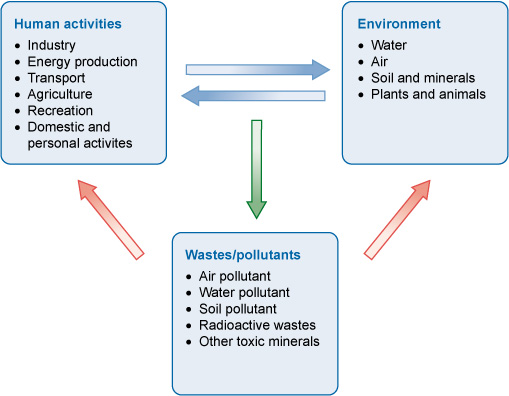
Figure i.8 Human–environment interaction and the generation of waste product and pollutants.
1.four Technology and the surroundings
Technologies accept transformed transport, industry, communications and our lives at dwelling house and work. For example, gadgets such as mobile phones, computers, televisions, microwave ovens and refrigerators have improved living standards for those people who tin can afford them. Technology can too improve the quality of our environment. For example, energy tin be generated from renewable sources such as wind and solar power, which reduces our reliance on not-renewable energy sources such as fossil fuels, and likewise helps to reduce the release of polluting gases to the atmosphere.
Another example of the benefits from technology is the highly advanced eco-friendly wastewater handling constitute at the St. George Brewery in Addis Ababa. This institute recovers nutrients and waste water from the brewery that would otherwise be released into the environment. This type of technology tin assistance to convalesce the problem of water shortage, prevent surface h2o pollution and protect the surround.
Although applied science has many positive impacts on people and the environment, it too has negative impacts, including the production of toxic waste from technological processes and electronic gadgets that are thrown abroad when they reach the terminate of their useful lives, every bit illustrated in Case Study 1.ii.
Case Written report 1.2 Eastward-waste in Federal democratic republic of ethiopia
When electronic equipment or gadgets get old or stop working they are often thrown abroad. This blazon of electronic waste product is referred to as e-waste. E-wastes pose a huge challenge to the surroundings considering they incorporate toxic substances such equally cadmium and lead from batteries, which leach out and pollute rivers and groundwater. (Leaching means the substances seep out or are washed out past rain into the soil below.) Toxic substances may get into the soil, making it unfit for agriculture. Copper from wiring is valuable for recycling, but if wiring is burned, it produces very chancy air pollution.
East-waste is becoming a major trouble in many African countries, including Federal democratic republic of ethiopia, where the use of electric equipment has increased sharply with the rising number of people on higher incomes. According to a United Nations University written report, there are about 4300 tonnes of non-performance computers, televisions, mobile phones and refrigerators in Ethiopia, mostly in the ten largest cities (Manhart et al., 2013).
Equally there is no proper east-waste management system in Ethiopia, some e-wastes are disposed of together with other household wastes or dumped in an uncontrolled way that may cause huge environmental bug. Figure 1.ix shows open solid waste matter disposal sites in Addis Ababa and Bahir Dar close to residential areas. All types of waste, including hazardous waste similar heavy metals, are discarded here without any treatment, so toxins can seep into the soil and groundwater. (Hazardous waste is any waste matter that contains cloth that is potentially harmful, for example, toxic, infectious, corrosive, explosive or flammable materials.)
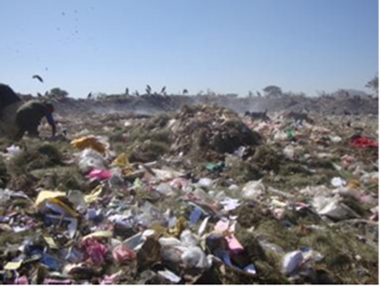
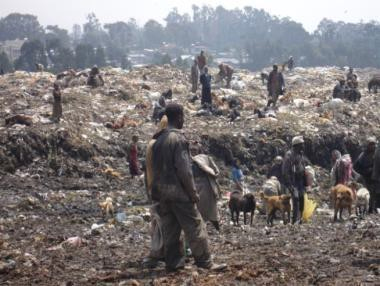
Figure 1.9 Uncontrolled waste product disposal in Bahir Dar (top) and Addis Ababa (bottom).
In that location is one due east-waste demanufacturing facility (DMF) in Addis Ababa managed by the regime. The DMF collects due east-waste product from governmental offices, dismantles them manually and sorts the dissimilar components to recover valuable metals (Effigy one.ten), which is an example of adept practice in e-waste material disposal.

Effigy ane.x Computer dismantling in the Demanufacturing Facility in Akaki, Ethiopia.
1.five Agronomics and environment
Agriculture is very of import in Ethiopia to provide essential food crops and as a source of income, contributing nigh 46% of our state's Gdp (GDP). About 80% of the labour forcefulness in Ethiopia is in the agronomical sector, so it is vital to the livelihoods of the majority of people. Still, agriculture besides has significant negative impacts on our environs, including loss of biodiversity, pollution, climate change, soil erosion and the use of large amounts of water for irrigation.
-
What problems practice you recollect are caused by using large amounts of water for agriculture?
-
This reduces the corporeality of water bachelor for other human purposes such as drinking and washing, and for sustaining wildlife and maintaining the levels of rivers and lakes.
Agricultural activities are as well major sources of water pollution. Pesticides and fertilisers applied to crops may wash into rivers and leach into soil and groundwater. (These furnishings are discussed in Study Session 8.)
Poor farming practices, especially on steeply sloping country, are a significant crusade of soil erosion in Federal democratic republic of ethiopia considering rainfall washes away the soil particles downhill. Each year more 1.five billion tons of soil are lost from the Ethiopian highlands (Tamene and Vlek, 2008). This lost soil is non only a problem for agriculture, it silts up rivers and lakes. Soil erosion and loss of soil biodiversity causes a decline in soil fertility and this in plough reduces agricultural productivity. Good agricultural practices, such as the employ of terraces and diversion ditches, can assistance cease soil being lost from hillsides (Effigy ane.xi).
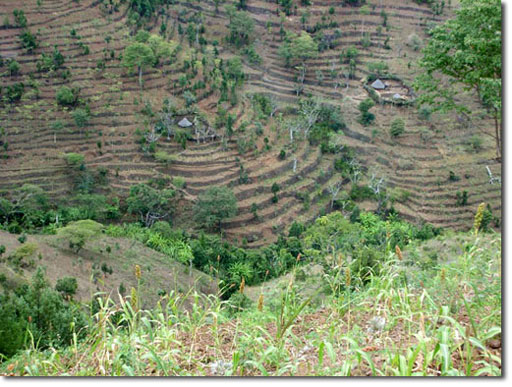
Figure 1.eleven Good agricultural practices such equally building terraces on sloping land helps to conserve soil.
Agriculture as well plays a role in causing climate change through the release of greenhouse gases into the atmosphere. For example, fertilisers added to the soil release nitrous oxide and livestock production releases methane from the digestion procedure in cattle and the decomposition of manure. The use of fossil fuels to power agricultural machines and burning trees to clear agricultural state both release carbon dioxide. In Study Session 9 you will learn more about climate alter and the part of greenhouse gases in changing our climate.
1.vi How nosotros can protect and restore our environment
We stop this study session with a positive message. Humans not merely affect the environs negatively – we can also contribute positively to sustaining information technology. When we install wastewater handling plants, protect endangered species and replant forests, nosotros have a positive impact on our environment. Since 2000, huge efforts accept been made in Ethiopia to increase the forest coverage through government and NGO reforestation programmes. More than 700 million copse were planted in 2007 lonely (AFP, 2010). Figure 1.12 shows people in Konso, Ethiopia, planting copse to celebrate Earth Environment Day 2012.In some parts of the country where the reforestation program has been implemented finer, the customs has already started to benefit from environmental improvements, through effects such equally creating more bound water, a higher water tabular array, and less soil erosion and flooding (Rinaudo, 2010).
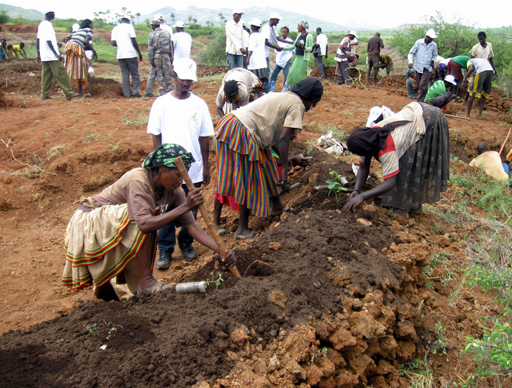
Figure one.12World Environs Day 2022 celebration in Konso.
Summary of Study Session ane
In Study Session i, you lot take learned that:
- Humans and the environment have been interacting since humans get-go walked the Earth. Humans change their surroundings both positively and negatively and the environment affects how humans live in many dissimilar means.
- The master interactions between humans and our environment can be grouped into the use of resources and the product of wastes.
- Resources can be classified as renewable (e.one thousand. water) or not-renewable (e.g. fossil fuels).
- Humans are extracting increasing quantities of natural resources from the Earth which is causing issues of over-exploitation, for example through overfishing and deforestation.
- Water is used for domestic, industrial and agricultural purposes. Some countries are classed as 'water stressed' or 'water scarce' because available supply does not meet need.
- Human being activities produce many different types of waste which can pollute the environment. One example is e-waste from discarded electronic gadgets such as mobile phones contain many toxic substances that can pollute groundwater, soil and air unless their disposal is well-managed.
- Agronomics is the ascendant economic activity in Ethiopia and has a significant impact on the utilise of resources, particularly water and soil. It too contributes to climate alter through the release of greenhouse gases (e.g. methyl hydride from cattle) into the atmosphere.
Self-Assessment Questions (SAQs) for Report Session 1
At present that yous have completed this study session, you can assess how well you have achieved its Learning Outcomes by answering these questions.
SAQ 1.one (tests Learning Outcome 1.ane)
The Glossary Game: Write down each of the fundamental words printed in bold in this report session. Cut the paper into strips with one word on each strip; fold them and put them into a bowl. Take a strip, read the word and write a definition in your notebook. Then check your definitions with those in the report session.
Answer
This game is intended to familiarise yous with the terms you will meet once again in subsequent study sessions. To observe the correct answer, you can check the definition written in your own words with that in the study session.
SAQ 1.two (tests Learning Upshot 1.2)
Which of the post-obit statements are simulated? In each example explicate why it is incorrect.
- A.Equally a population increases, the amount of natural resource extraction and consumption increases.
- B.Agronomics doesn't have whatsoever negative impacts on the environment.
- C.As a population increases, more than waste is produced as a issue of increased activity.
- D.The environment influences man beings, both positively and negatively.
- East.The touch of human activity on the environment is always damaging.
Answer
B is false. Agronomical activity can have meaning negative impacts on our surroundings, including loss of biodiversity, water contamination, climate change, soil erosion and pollution.
E is as well imitation. Some human activity tin can forestall harm or repair by damage, for instance recovery of hazardous materials from waste and reforestation programmes where many trees are planted. It is important to work towards creating a improve environment in gild to protect our health, and considering ecology improvements such as tree-planting can have many beneficial effects, such as creating more spring water, a college h2o table, and less soil erosion and flooding.
SAQ one.3 (tests Learning Outcomes 1.1 and 1.3)
Explain why biomass resources are classified every bit renewable. Give two examples of biomass resources that tin be over-used despite being renewable. What are the consequences of their over-exploitation?
Respond
Biomass resource are derived from living organisms. They are renewable considering they are replaced by the continuing processes of growth and reproduction. Even so, they are vulnerable to over-exploitation if they are used more quickly than they can naturally reproduce and regenerate. Overfishing and deforestation are examples of the over-use of biomass resources. The consequences include loss of biodiversity and loss of income for the people who depend on these resources for their livelihood.
SAQ 1.four (tests Learning Outcome 1.4)
Imagine you have a colleague who e'er blames applied science for environmental issues. What would you lot say to your colleague to demonstrate that technology affects the environs in both a positive and a negative manner?
Answer
You could first by maxim that technology plays an of import office in improving the quality of our lives and our environment. For example, we employ renewable energy such as wind and solar ability to reduce the release of greenhouse gases, and we use high-tech waste treatment plants to protect h2o sources from pollution. Merely you would concur that technology can also impairment the surroundings. For instance, e-wastes contain many toxic substances that can pollute groundwater, soil and air. And so your conclusion is that technology tin can have both positive and negative environmental impacts.
Source: https://www.open.edu/openlearncreate/mod/oucontent/view.php?id=79926&printable=1
0 Response to "How Can Human Systems in Response in Physical Environment Conditions"
Post a Comment